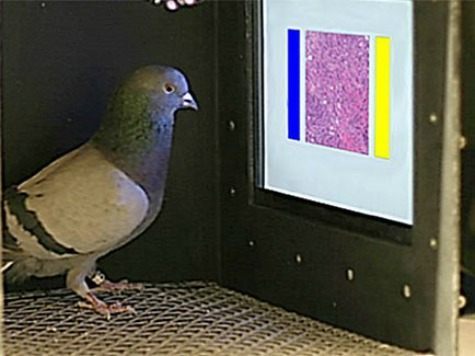A surrogate for observers of medical images may have been found by researchers from the University of California, Davis: pigeons.
Researchers associated with UC Davis found that when pigeons were trained to peck a screen when they spotted disease, they learned to distinguish between benign breast tissue samples and malignant slides. The study stated:
The birds proved to have a remarkable ability to distinguish benign from malignant human breast histopathology after training with differential food reinforcement; even more importantly, the pigeons were able to generalize what they had learned when confronted with novel image sets.
Lead author Richard Levenson, professor of pathology at UC Davis, told the San Francisco Chronicle:
With some training and selective food reinforcement, pigeons do just as well as humans in categorizing digitized slides and mammograms of benign and malignant human breast tissue. The birds were remarkably adept at discriminating … a task that can perplex inexperienced human observers, who typically require considerable training to attain mastery.
The study made clear that the birds had limitations, admitting:
The birds proved to be similarly capable of detecting cancer-relevant microcalcifications on mammogram images. However, when given a different (and for humans quite difficult) task—namely, classification of suspicious mammographic densities (masses)—the pigeons proved to be capable only of image memorization and were unable to successfully generalize when shown novel examples.
The report acknowledged research over the last half-century has shown pigeons can distinguish “foreground from background, misshapen pharmaceutical capsules, letters of the alphabet, basic object categories such as cats, flowers, cars, and chairs, identities and emotional expressions of human faces, and even paintings by Monet vs. Picasso.” Pigeons can also retain over 1,800 images.
The Susan G. Komen Foundation has stated, “Mammography correctly identifies about 84 percent of women who truly have breast cancer.” The pigeons’ success rate was comparable; the study asserted:
During a 5-day period after the end of training at each magnification level, pigeons were given a small number of novel benign and malignant breast tissue images intermixed with the full set of familiar training images. … [T]he birds had gained the ability to accurately classify novel as well as familiar benign and malignant images, and with equal accuracy, averaging 87% and 85% correct on familiar and novel examples.
The report stated:
Our research suggests that avian observers might be able to deliver relevant assessments of image diagnostic content and quality, as their performance is reproducible and can easily and quantitatively be tracked by modern conditioning techniques … We found pigeons to be remarkably adept at several medical image classification tasks. They quickly learned to distinguish benign from malignant breast cancer histopathology at all magnifications, a task that can perplex inexperienced human observers who typically require considerable training to attain mastery, although the examples shown are easily classified by a trained pathologist.
The study concluded, “Overall, our results suggest that pigeons can be used as suitable surrogates for human observers in certain medical image perception studies, thus avoiding the need to recruit, pay, and retain clinicians as subjects for relatively mundane tasks.”

COMMENTS
Please let us know if you're having issues with commenting.